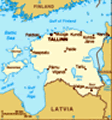Advertisement
Published: October 22nd 2015
Narva is the closest Estonian town to St. Petersburg so it was quite natural that I decided to visit it. The tickets were a bit expensive despite the very short distance, mere 150 kilometers, covered within about 2 hours and a half on SimpleExpress bus.
Narva is the largest Russian-speaking Estonian town, very important in the development of relations between the two countries. Its official date of founding is the construction of Narva Castle in 1223. Narva was seized by Russian troops in 1558, when Ivan the Terrible wanted to make Narva a major port on the Baltic Sea. It was Ivan the Terrible who built the Ivangorod Fortress opposite Narva. Soon Sweden and Russia started a war and the Swedes managed to capture it. Peter the Great took Narva in 1704. I think after that time the town had remained under Russian power until Estonia became fully independent.
I have actually been in Narva at the border crossing about 4 or 5 times, and I’ve been on a guided tour to the Ivangorod Fortress on the opposite bank of the river. Now it was high time to pay a short visit to Narva.
After the Russian border,
I crossed the Estonian border, opened the door of the border check point and – lo and behold! – here I was in Narva at about 11 o’clock in the morning. My return bus was at about 15-00 so I had a couple of hours for sightseeing.
I saw the signpost of a tourist information centre and went there for a map and the consultant there told me everything in my native Russian about what I should see. I got a map and booklet about Narva.
I thanked her and went immediately to the Narva Castle. It was built by the Danes in the XIII century. While walking in Narva you can accidentally cross the border… or can you not? At least, you’ll be always reminded of this fact by barbed wire and other obstructions in places, and Narva Castle is located just by the side of the border crossing point. I entered its grounds and enjoyed the castle from all angles. It was possible to ascend the tower but I did not to. Many ramparts from the old times remained in the vicinity.
Despite the overwhelming Western Russophobia, Narva surprised me by a monument, in the
park adjoining the castle, to the soldiers perished during the Great Patriotic War (an inscription in the Russian language, and a five-point star with a hammer and sickle on top).
All I saw around me looked neat and jolly, the sun was shining, and my heart filled with merriness. There were few people in the streets.
From the height of the Narva Castle’s foot I enjoyed the grand view of the Russian Ivangorod Fortress. While Narva Castel is square in shape, the walls of Ivangorod Fortress are long, like a big rectangle. They are face to face and below them is the border crossing bridge. On the castle’s grounds another great surprise was in store for me – a statue of Lenin the Great! Despite the Western Russophobia, as I’ve mentioned; and certain countries might teach how to destroy undesirable monuments. To destroy is simpler than to build. The statue looked completely out of place there, but I guess it is related to the country’s history (there’s a historic exhibition in the castle).
I then left the fortress and descended down to the river. The Ivangorod Fortress looked so amazing from there I even thought it the
best fortress view in the whole Russia (from what I’ve seen). People were strolling on the embankment (running both ways under the bridge). You might try and swim across the river and in a minute you’d be in Russia. There was a signpost about the construction of the town’s beach and safety in relation thereto, in three languages (guess which). Then I consulted my map (there were two churches to be seen and a lion’s statue). The lion commemorated the battle at Narva in 1700 between Peter I and Sweden’s Karl XII.
I saw the first church, found the bus station (near the train station), and an interesting monument to political repression victims with the beautiful words “Memento Mori” on a granite stone. Then I saw the second church, rather colourful in appearance. I proceeded back to the town’s centre on Pushkin Street, and saw the Townhall Square. Then I descended on the embankment and walked there for a short while before deciding to find a shopping mall for nutrition. I think the embankment was recently built or at least renovated, because I dimly recollect some mental views of construction works during my previous border crossings there.
I
found a shopping mall and there ate at Pechki Lavochki, Russian cuisine, for 5 Euro. Refreshed, I started going back to the bus station to catch my bus. To summarize, Narva coupled with Ivangorod fortress deserve a day’s visit.
Advertisement
Tot: 0.087s; Tpl: 0.013s; cc: 12; qc: 29; dbt: 0.0581s; 1; m:domysql w:travelblog (10.17.0.13); sld: 1;
; mem: 1.1mb




























